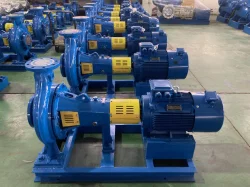Here are the main components and principles of operation of a centrifugal pump
2024-04-24
A centrifugal pump is a mechanical device used to transport fluids by converting rotational kinetic energy into hydrodynamic energy. These pumps are widely used in various industries for applications such as water supply, wastewater treatment, irrigation, chemical processing, and HVAC (heating, ventilation, and air conditioning) systems. Here are the main components and principles of operation of a centrifugal pump:
1. Impeller: The impeller is the rotating component of the centrifugal pump responsible for imparting energy to the fluid. It typically consists of curved blades or vanes that accelerate the fluid radially outward when the impeller rotates. The design of the impeller determines the pump's performance characteristics, such as flow rate, head, and efficiency.
2. Casing or Housing: The casing or housing of the centrifugal pump surrounds the impeller and serves to contain the fluid being pumped. It is designed to direct the flow of fluid from the inlet to the outlet of the pump. The casing may have a volute or diffuser shape to help convert kinetic energy into pressure energy as the fluid passes through it.
3. Inlet and Outlet: The inlet of the centrifugal pump is where fluid enters the pump, while the outlet is where the pumped fluid is discharged. The size and configuration of the inlet and outlet connections depend on the specific application and flow requirements of the pump.
4. Shaft: The shaft of the centrifugal pump connects the impeller to the motor or prime mover that drives the pump. It transmits the rotational motion from the motor to the impeller, causing it to spin and impart energy to the fluid. The shaft must be properly aligned and supported to ensure smooth operation and minimize vibration.
5. Seals and Bearings: Seals are used to prevent leakage of fluid from the pump, while bearings support and guide the rotation of the shaft. Common types of seals used in centrifugal pumps include mechanical seals, packing seals, and lip seals. Bearings may be ball bearings, roller bearings, or journal bearings, depending on the pump design and operating conditions.
6. Prime Mover: The prime mover is the source of mechanical energy that drives the centrifugal pump. It can be an electric motor, diesel engine, steam turbine, or other power source depending on the application and available resources. The prime mover provides the torque required to rotate the pump shaft and impeller.
7. Suction and Discharge Piping: Suction piping connects the pump inlet to the fluid source, while discharge piping connects the pump outlet to the desired destination for the pumped fluid. Proper sizing and configuration of the piping system are essential to minimize friction losses and optimize pump performance.
8. Control and Monitoring Devices: Centrifugal pumps may be equipped with various control and monitoring devices to ensure safe and efficient operation. These devices can include pressure gauges, flow meters, temperature sensors, level switches, and automatic shut-off valves.
In operation, the impeller of the centrifugal pump spins at high speed, creating a centrifugal force that accelerates the fluid radially outward from the center of the impeller. As the fluid moves through the pump casing, it gains velocity and pressure energy, resulting in an increase in fluid velocity and pressure. The fluid is then discharged from the pump through the outlet piping to the desired location.
Overall, centrifugal pumps are versatile and efficient devices for transporting fluids in a wide range of industrial, commercial, and residential applications. Their relatively simple design, high flow rates, and ability to handle a variety of fluids make them indispensable in many industries.



